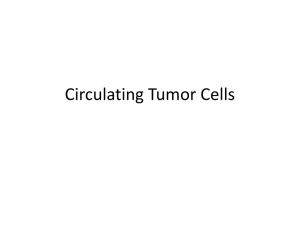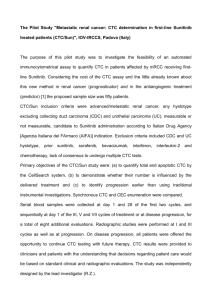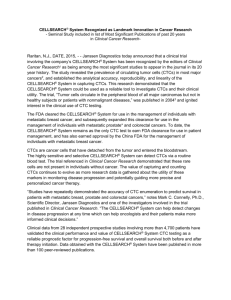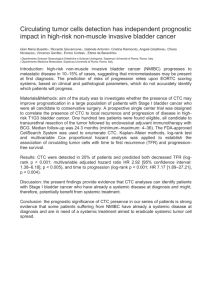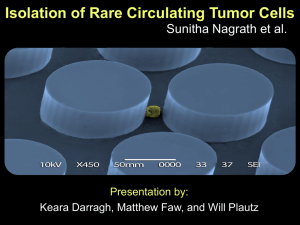Circulating Tumor Cell Technology: A New Paradigm for the
advertisement
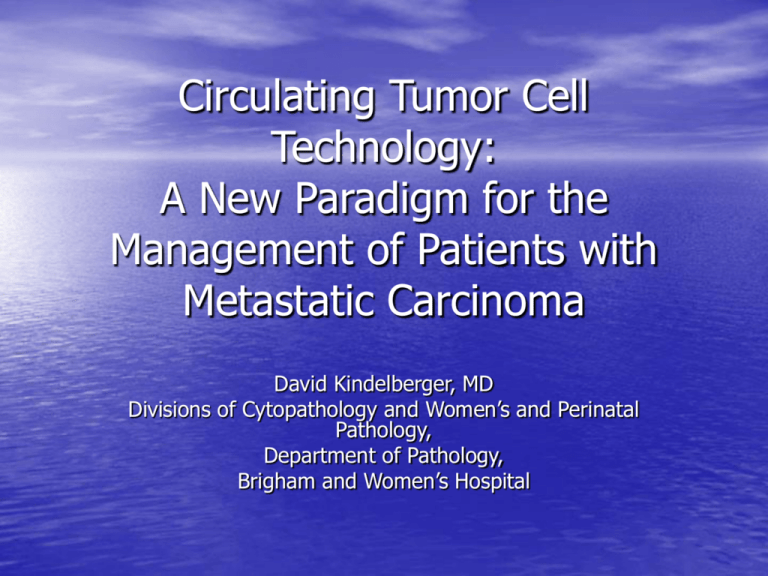
Circulating Tumor Cell Technology: A New Paradigm for the Management of Patients with Metastatic Carcinoma David Kindelberger, MD Divisions of Cytopathology and Women’s and Perinatal Pathology, Department of Pathology, Brigham and Women’s Hospital Financial Disclosures • Dr. Kindelberger has no relationships to commercial interests relating to the content of this presentation. Outline • Introduction to CTC technology • Current paradigm for using CTCs to manage cancer patients • Personalized medicine with lung cancer as a model • Emerging roles for CTCs and molecular pathology in managing cancer patients Tumor Metastasis • Metastatic disease is primary cause of death in most cancer pts. • Tumor metastasis involves a series of discrete steps – Invasion of surrounding tissue – Survival and arrest in bloodstream – Colonization Tumor Metastasis Once in circulation, cells must 1. Survive—harsh environment -shear forces -lack of substratum -immune cells 2. Attach 3. Extravasate Nature Medicine 12,2006 New Models of Tumor Metastasis Klein, Science 321, September, 2008 CTC • 1869 Australian Medical Journal: A Case of Cancer in • • which Cells Similar to Those in the Tumors were Seen in the Blood After Death 1869;14:146. 1955 Acta Chiurgica Scandinavia: Cancer Cells Circulating in the Blood: a Clinical Study on the Occurrence of Cancer Cells in the Peripheral Blood and in Venous Blood Draining the Tumor Area at Operation 1955;201:1. 1976 American Journal of Medicine: Carcinocythemia: An Acute Leukemia-like Picture Due to Metastatic Carcinoma Cells 1976;60:273. Isolation of CTC from Peripheral Blood • Two Key Issues: – Enrichment of epithelial/tumor cells from RBC & WBC – Characterization to distinguish • Tumor cells from blood components • Tumor cells from normal cells Isolation of CTC from Peripheral Blood Enrichment Methods: Filtration Density gradient Immunomagnetic Isolation of CTC from Peripheral Blood Isolation of CTC from Peripheral Blood Immunomagnetic Selection of CTC Isolation of CTC from Peripheral Blood • Two Key Issues: – Enrichment of epithelial/tumor cells from RBC & WBC – Characterization to distinguish • Tumor cells from blood components • Tumor cells from normal cells Immunomagnetic Selection of CTC Distinguishing CTC after Enrichment Labeling of CTC and Blood Cells Anti-EpCAM Ferrofluid EpCAM Anti-EpCAM Ferrofluid CD45 EpCAM Nucleus DAPI HER2 CK CK AntiCK-PE Circulating Tumor Cell AntiHER2PE-Cy7 Nucleus DAPI Y Nucleus DAPI AntiCK-PE HER2+* Circulating Tumor Cell Leukocyte Anti CD45-APC Magnetic Cell Presentation Analysis Cartridge Trajectory of magnetically labeled objects Analysis of Enriched CTC • Semi-automated fluorescence microscope • Automatically scans a complete reaction cartridge in about 10 minutes • Software algorithm identifies CTC candidates • Cell images are presented in a gallery format for confirmation as CTC by a technician or pathologist CellSpotter Analyzer Analysis of Enriched CTC Composite Leukocyte Intact Tumor Cells Control Cytokeratin Nucleus Generalizability Clinical Cancer Research 10, 2004 Generalizability Clinical Cancer Research 10, 2004 The Current CTC Paradigm for Metastatic Carcinoma Treatment Efficacy in Metastatic Breast Cancer Monitoring Metastatic Disease • Multicenter, prospective trial • Inclusion criteria: – Progressive metastatic breast cancer – All beginning new systemic therapy – All with measurable disease – All with ECOG (Eastern Cooperative Oncology Group) performance status of 0-2 (no to moderate symptoms) NEJM 351, 2004 Number of CTC Before New Therapy Predicts Progression Free Survival and Overall Survival Number of CTC at First Follow Up Predicts Progression Free Survival and Overall Survival Number of CTC at First Follow Up Predicts Progression Free Survival and Overall Survival Conclusions • The levels of baseline CTC are independent • • prognostic markers of outcomes (both progression free survival and overall survival) Elevated levels of CTC at First Follow-Up predict both short progression free survival and overall survival—may indicate that pt. is receiving futile therapy. CTC levels give reliable estimates of disease progression much earlier than with traditional imaging methods (3-4 weeks vs. 8-12 weeks) Lung Cancer As a Model for Personalized Medicine Lung Cancer-Overview • NSCLC is most common cause of cancer- related deaths in West. • 50% of pts. present with mets. AND 40% present with locally advanced disease. • For pts. with advanced cancers, chemotherapy is mainstay of treatment. • Median survival is 8-9 months. The EGFR Story • By IHC, EGFR is detected in between 40 and • 80% of NSCLC. Using the analogy of c-KIT in GIST, companies developed 2 small molecule EGFR inhibitors – Gefitinib (Tarceva) – Irlotinib (Iressa) • Specific subsets of patients showed significant survival increases (double) Characteristics of Pts. Likely to Respond to EGFR Inhibitors Group Response Rate (%) P value Women vs. Men 19 vs. 3 .001 Japanese vs. White 27.5 vs. 10 .0023 Adeno vs. others 13 vs. 4 .046 Never-smoker vs. others 36 vs. 8 <.001 Types of EGFR Mutations in Responders Action of EGFR Inhibitors Cell Growth Apoptosis Resistance to EGFR Inhibitors Cell Growth EGFR Mutation Analysis using Circulating Tumor Cells NEJM, 2008 A Short Digression Variations on a CTC Theme Nature 2007;450: 1235 Variations on a CTC Theme Nature 2007;450: 1235 Now Back to our Story… Direct Sequencing of EGFR from Isolated CTCs Resistance to EGFR Inhibitors Cell Growth Cell Growth FISH on Lung CTCs Green is CEP 7, Red is EGFR, Blue is MET Polysomy/polyploidy CTC FISH Data Analysis CTC FISH Data Analysis The New Paradigm • With a single blood draw, one can – Confirm EGFR, MET, other oncogene amplification – Acquire material for direct sequencing of EGFR – Enumerate baseline CTC levels to use as monitor for efficacy of selected therapy – Patients may never need to have a biopsy/Cmed Why Cytology? Clinical Cancer Research 10, 2004 Future Directions • Filtration Systems for isolation of CTCs – Allows for assessment of non-epithelial tumors (Melanoma, etc) • Fiberoptic Array Scanning Technology (FAST) following direct isolation – Gentle procedure allowing for little disruption of cytomorphologic features Future Directions • Filtration Systems for isolation of CTCs – Allows for assessment of non-epithelial tumors (Melanoma, etc) • Fiberoptic Array Scanning Technology (FAST) following direct isolation – Gentle procedure allowing for little disruption of cytomorphologic features Future Directions • Filtration Systems for isolation of CTCs – Allows for assessment of non-epithelial tumors (Melanoma, etc) • Fiberoptic Array Scanning Technology (FAST) following direct isolation – Gentle procedure allowing for little disruption of cytomorphologic features Archives of Pathology and Laboratory Medicine, Sept. 2009 Archives of Pathology and Laboratory Medicine, Sept. 2009 Ongoing Studies • Combination Drug Therapies in Metastatic Breast Cancer with Hal Burstein – Enumerating CTCs during treatment with Herceptin/Avastin/Vinorelbine (HAV) • Combination Drug Therapies in Metastatic Breast Cancer with Gerburg Wulf (BIDMC) – Enumerating CTCs during treatment with Fulvestrant and Lapitinib Ongoing Studies • Molecular Characterization of Breast Cancer with Ian Krop – Comparison of primary tumor with CTCs with mets. Ongoing Studies • Molecular Characterization of Breast Cancer with Ian Krop – Comparison of primary tumor with CTCs with mets. • Utility of CTCs as Early Predictors of Recurrence in Metastatic Ovarian Carcinoma with Ursula Matulonis – Enumeration of CTCs to be used in combination with MMP levels in urine. Ongoing Studies • Utility of CTC as a predictor of response to therapy in patients with Metastatic Squamous Cell Carcinoma from the Cervix with Michael Birrer • CTCs in patients with Metastatic Prostate Carcinoma with Glen Bubley (BIDMC)
